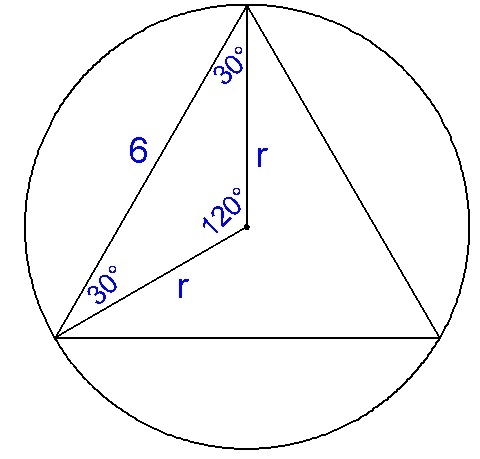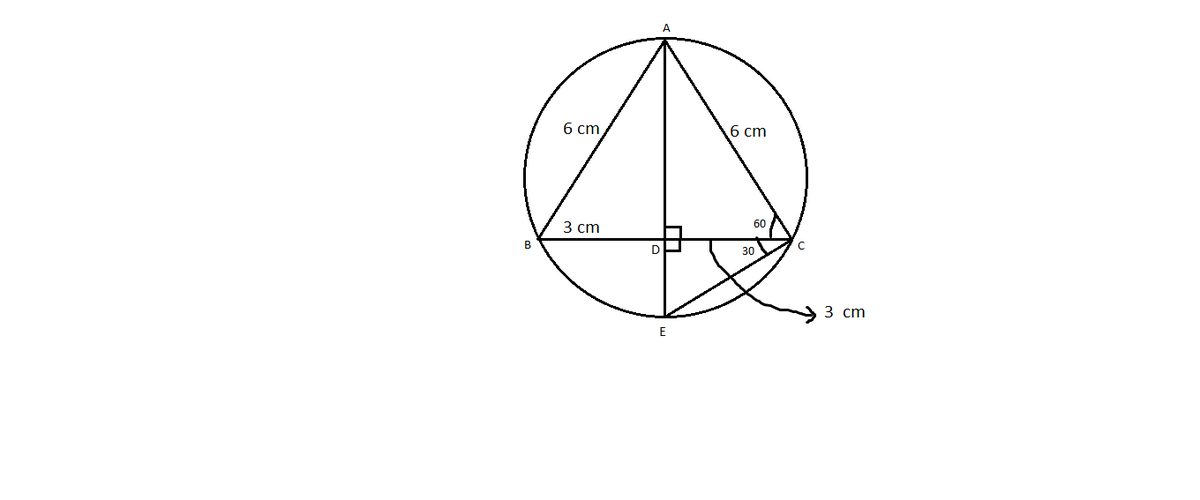Triangle in circle
In the figure, △ A B C is an equilateral triangle where A B = 6 cm. The area of the circumcircle is k π cm 2 . Find the value of k .
The answer is 12.
This section requires Javascript.
You are seeing this because something didn't load right. We suggest you, (a) try
refreshing the page, (b) enabling javascript if it is disabled on your browser and,
finally, (c)
loading the
non-javascript version of this page
. We're sorry about the hassle.
6 solutions
 By cosine law,
By cosine law,
6 2 = r 2 + r 2 − 2 ( r ) ( r ) cos 1 2 0
3 6 = 2 r 2 − 2 r 2 cos 1 2 0
r 2 = 1 2
The area of a circle is given by the formula: A = π r 2 where r is the radius. It follows that k = r 2 .
So,
k = 1 2
Center of the circle = Centroid of the triangle...
altitude of Eq. triangle = sqrt(3) / 2 * side of the triangle...
Centroid divides each of the medians in the ratio 2:1...
Hence radius of the circumcircle will be (2/3) * altitude of Eq. triangle => (2/3) * sqrt(3) / 2 * side of the triangle
=> r = (2/3) * (sqrt(3) / 2 * 6) = 2 * sqrt(3)
Here k = r * r
k = 4 * 3 = 12.
Moderator note:
There's a simpler approach.
Hint 1 : Sine Rule.
Hint 2 : sin A a = sin B b = sin C c = ?
Hint 3 : We can replace the question mark with twice the circumradius of the triangle. What is the formula of an area of a circle?
Any direct formula for finding circumradius and Inradius of a circle ?
Log in to reply
Yes. Look it up on brilliant and other sites.
This is the easiest method to solve this thing, albeit a bit long.
 So, we know that the median of an equilateral triangle passes through the center of a circle, it is also the perpendicular bisector of the side it falls on(the side in our case is BC). So we construct chord AE, which is the diameter as it is passing through the center. Therefore, AE divides our circle into 2 semi-circles.
This implies,
- Angle ADC = Angle EDC = 90
Now,
- Angle ACE = 90(Since angle in a semicircle is 90)----------------------(Equation 1)
- Angle ACD = 60(Since triangle ABC is equilateral)---------------------(Eq. 2)
From Eq(1) and (2),
Angle ECD = 30(Angle ACE - Angle ACD)
Now applying trigonometric values,
- cot30 = \sqrt{3} =
D
E
3
Therefore,
- DE =
3
3
= \sqrt{3}
Now,
So, we know that the median of an equilateral triangle passes through the center of a circle, it is also the perpendicular bisector of the side it falls on(the side in our case is BC). So we construct chord AE, which is the diameter as it is passing through the center. Therefore, AE divides our circle into 2 semi-circles.
This implies,
- Angle ADC = Angle EDC = 90
Now,
- Angle ACE = 90(Since angle in a semicircle is 90)----------------------(Equation 1)
- Angle ACD = 60(Since triangle ABC is equilateral)---------------------(Eq. 2)
From Eq(1) and (2),
Angle ECD = 30(Angle ACE - Angle ACD)
Now applying trigonometric values,
- cot30 = \sqrt{3} =
D
E
3
Therefore,
- DE =
3
3
= \sqrt{3}
Now,
- cosec 60 =
A
D
3
=
3
2
Hence,
- AD = 3\sqrt{3}
Now, diameter = AE = AD + DE = \sqrt{3}+3\sqrt{3} = 4\sqrt{3}
Area of Circle = πr^{2} = π x
2
A
E
^{2} = kπ cm^{2}
Therfore,
- π x
4
A
E
2
= π x
4
4
8
= 12π = kπ
On comparing LHS and RHS,
- k = 12
Hence, k = 12
Using Extended Sine Rule, we have that
sin ( 6 0 ∘ ) 6 = 2 R
where R represents the circumradius. Solving the above equation, we have
2 3 3 = R
R = 3 6
The area of the circumcircle is
π × R 2 = π × 3 3 6 = 1 2 π
Therefore, k = 1 2 .
I think that's the way I did it. What's interesting is that the area of the square that a side of the triangle makes, is 3 times larger than the area of the square that radius of the circle makes
Form sine formula...... (6/sin60°)=2R................... We know the area of the circle......πR^2=12π.......... Here angle is 60° .because it is an equal sides triangle.
Let O be the centre of the circle/triangle, and let r be the radius of the circumcircle. Consider △ O A B , △ O B C or △ O C A :
s i n 1 2 0 6 = s i n 3 0 r r = 2 3 6 × 2 1 = 2 3
The area of a circle is π r 2 , therefore k = r 2 = 4 × 3 = 1 2